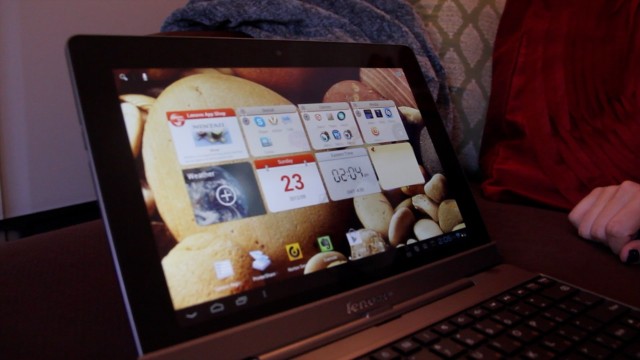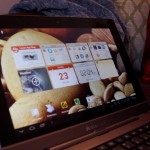As more tablets and touchscreens come to market, more solutions are emerging for consumers who like the feel and satisfying click of physical keyboards. I happen to be one of those consumers, which is why I had high hopes for Lenovo’s IdeaPad S2110.
This $399, 10-inch tablet, which came to market last month, is built to work with an optional, attachable $100 keyboard. And the keyboard goes beyond just keys: It also provides several extra hours of battery life and two USB ports, marrying the consumption-friendly features of a lightweight tablet with the productivity features of a laptop.
The idea of the convertible PC — a term that applies to laptops and tablets with adjustable form factors — isn’t a new one. Lenovo introduced the convertible ThinkPad X41 tablet back in 2005, and currently sells a Windows 7 ThinkPad convertible, the ThinkPad x230, for $1,150. One of the IdeaPad S2110’s closest current competitors is the $499 Asus Transformer Pad Infinity TF700, an Android tablet that comes with an optional keyboard for $150.
But while the power-packed IdeaPad is a solid device for people who want both a tablet for fun and a laptop-like solution for work, there are a few reasons to walk, not run, to buy this convertible.
The IdeaPad is one of just a few Lenovo devices running on a Google Android operating system instead of Windows, a deviation from Lenovo’s longtime support of Windows operating systems. But it runs on last year’s Android 4.0, and there’s no guarantee that an upgrade to the newest Jelly Bean 4.1 operating system will be available.
I also experienced a few software glitches with the first IdeaPad I tested, a Lenovo lab-tested model. The company later supplied me with a new model, which showed notable improvements, but one of the problems — a black flash across the screen when I was watching movies — persisted.
Lastly, a variety of PC form factors will be ushered in with the launch of the upcoming Windows 8 operating system, so consumers who are sold on the convertible form factor but not tied to Android may want to hold off another month before buying.
The IdeaPad measures 10.2 inches by 7.0 inches, and is .34-inch thick. The tablet alone weighs 1.3 pounds, the same weight as the Asus Transformer Pad without its keyboard, and slightly less than the new iPad. With the keyboard attached, the IdeaPad’s weight doubles.
The IdeaPad is coated with durable, textured plastic. It’s mostly matte-black, with a pewter-silver strip at the hinge where the keyboard fits. When coupled with the keyboard, it has gently rounded edges and looks like a black notebook.
While I think it’s better-looking than Lenovo’s ThinkPad line of business PCs, which tend to be boxy, this IdeaPad lacks some of the pizzazz of other consumer PCs. It’s functional but not sexy, like a buttoned-up professional trying to let loose at the after-work party, without really succeeding.
The IdeaPad has a speedy, dual-core, 1.5GHz Snapdragon S4 processor. The base model includes 16 gigabytes of internal storage and 1GB of RAM. When powering on, I had to firmly press the power button for a few seconds, and the tablet runs through a Lenovo graphic before the home screen appears, which made boot-up time feel slow compared to other tablets.
It has a 10.1-inch, glossy touchscreen, with a 1280 by 800 LED HD display. This isn’t as brilliant as the Asus Transformer Pad Infinity’s full-HD, 1920 by 1200 display. But, in the handful of new movies I watched on the IdeaPad, colors were still vibrant, with good contrast.
And that’s when I experienced that weird bug: Whenever I adjusted volume, using the buttons on the right-hand side of the tablet, its screen would flash to black for a second, as though it were blinking. Lenovo didn’t really have an explanation for this.
The IdeaPad interface is made up of small, Post-it-like squares that categorize apps by themes, like Social, Games, Media and Lenovo’s own App Shop. As with other Android tablets, tiny movable app icons litter the rest of the space.
Since I’m a Google apps user, I only had to sign into my account once to sync my email, calendar, documents, Google+ account and Google Apps account. For Microsoft Office users, the tab comes with a built-in app called Documents to Go, which lets users create, view and edit Word, Excel and PowerPoint files.
While I’m still not sold on the idea of using a 10-inch device to take pictures, tablet shutterbugs won’t be impressed by the cameras on this one. In my experience, pictures taken with the five-megapixel rear camera came out grainy and, even with the option to adjust the exposure, photos taken in low light looked dark. The camera app has a panorama picture option, but in my test, the living room came out looking a little psychedelic.
And while Lenovo claims 10 hours of battery life for the IdeaPad, in my test — which involves setting the display’s brightness to 75 percent, playing videos nonstop and running an email application — it lasted just under six hours. This isn’t even close to what the new iPad and iPad 2 get, and an hour-and-a-half less than the battery life of the Android-based Samsung Galaxy Note 10.1, all determined with our same battery tests.
That’s where the keyboard came in handy. After running down the battery, I inserted the tablet into the keyboard dock — which requires a bit of force — and the keyboard battery powered up the tablet.
Lenovo says that this should provide up to 10 extra hours of battery life. I wasn’t able to fully test that claim, but after watching two movies back to back one night, with the tablet docked on the keyboard, the keyboard was drained, but the tablet’s battery was still at 90 percent. When you plug the tablet-plus-keyboard into a wall outlet, the tablet gets charged first, so you don’t end up with a fully charged keyboard and a dead tablet.
With the keyboard as its saving grace, the IdeaPad is a decent convertible, though as a standalone tablet it lacks the style and features of some of its premium competitors.

















